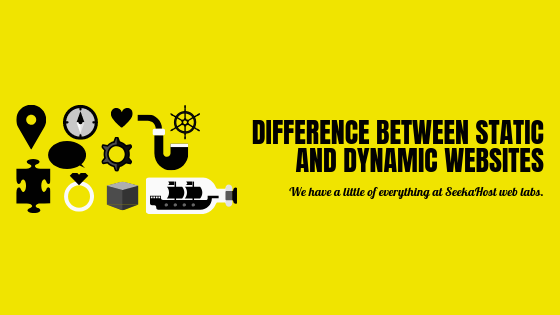
Difference between Static and Dynamic Websites
Websites are an essential means to communicate your services to online users worldwide. And as a web designer, I get asked about the difference between a static and dynamic website.

When designing a website you must have often encountered the term ‘Static or Dynamic Websites’. Static means fixed and dynamic means flexible or changeable. These are the two ways in which you or your web developer carries out the process of website designing.
Static websites
These are quite simple to create and doesn’t involve much development skills and coding. With basic HTML (HyperText Markup Language) and CSS (Cascading Style Sheets) knowledge, you can build static web pages.
They contain a collection of text, multimedia, audio/video, and graphics. These pages have a fixed format and the number of pages is also fixed. When the end-user or the client view static websites on their browser (irrespective of the device) it will be displayed exactly the same everywhere.
In case any changes are to be made according to the client’s browser, screen size, operating system or regional language, then the original source code needs to be modified. School or educational sites are mostly static websites.
Dynamic Website
Unlike static websites, dynamic websites are changeable. This means that the webpage can be modified and displayed dynamically in a different manner for different users.
[Tweet “A dynamic website can appear different on the laptop and altogether different in mobile.”]
The reason being that dynamic websites are designed and coded by the means of server-side programming such as PHP, JSP, ASP.net, C#.net etc…and various frameworks which enables to modify the code during run time.
Using the server-side scripting this website can interact with the database, handle event, cookies and sessions and the dynamic design is achieved using client-side scripting. All social networking sites, commercial sites are examples of dynamic websites.
To bring it down in comparison and concise form, here are the contrast features of both the websites.
Static Website
- Have non-variable format and pages
- Static pages load quickly since it doesn’t involve server request
- Modification of static webpages is tedious since the entire page needs to be modified and loaded again
- They are easy to code. HTML and CSS are the foundation of Static web pages which are saved with file extensions as .html or .htm
- They are easy and cheap to develop/maintain as it doesn’t require any CMS (Content Management System) and database management.
Dynamic Website
- The dynamic webpage can be modified during run time
- Dynamic pages load slowly compared to static since it involves the request of the server.
- The server application modifies the dynamic pages automatically.
- Complex in coding. Programming and scripting languages like PHP, JSP, JavaScript, .net etc… are used to develop dynamic sites.
- Unlike static websites, dynamic websites incur more cost as they require CMS, database, hosting provider and dynamic languages.
Now that you have an overview of both static and dynamic websites, the question lies which is the ideal one to opt for?
The answer is simple, if your website is more of information-based, doesn’t involve any database transactions and do not require a frequent update of contents, then static websites will solve your purpose.
On the other hand, there are numerous reasons as well as benefits for those who want to go for dynamic websites.
[Tweet “Know the Difference between Static and Dynamic Websites!”]

